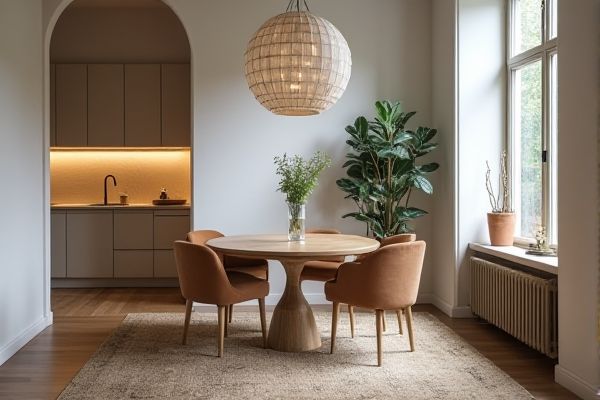
Narrow tables maximize space efficiency and fit well in tight dining areas, while round tables encourage more intimate conversations by allowing everyone to face each other evenly. Discover which table shape suits Your space and social dynamics best by reading the rest of this article.
Table of Comparison
| Feature | Narrow Table | Round Table |
|---|---|---|
| Shape | Rectangular or elongated | Circular |
| Space Efficiency | Better for tight spaces, fits narrow rooms | Requires more floor space, better in open areas |
| Seating Capacity | Optimized for linear seating, fewer seats per length | Equal seating around the table, encourages interaction |
| Social Interaction | Limited across table, better for focused tasks | High interaction, ideal for group discussions |
| Use Cases | Work desks, dining in narrow rooms, conferences | Family dining, teamwork, informal meetings |
| Visual Aesthetic | Sleek, linear design | Soft, balanced look |
Introduction to Table Shapes: Narrow vs Round
Narrow tables are ideal for tight spaces, providing a streamlined surface that maximizes seating along a lengthy design, perfect for corridors or small dining areas. Round tables foster a more intimate and inclusive atmosphere by eliminating sharp corners, encouraging equal interaction among diners or participants. Your choice between narrow and round table shapes impacts room flow, seating capacity, and social dynamics in both home and office settings.
Space Efficiency: Narrow vs Round Tables
Narrow tables maximize space efficiency by fitting snugly against walls or in tight corridors, making them ideal for small rooms and hallways where floor space is limited. Round tables, while less space-efficient due to their shape, encourage social interaction by allowing equal seating without sharp corners, but they require more clearance around for comfortable movement. Your choice should balance room size and seating dynamics, prioritizing narrow tables for compact areas and round tables when promoting inclusive conversation is key.
Seating Capacity Comparison
Narrow tables typically maximize seating capacity along elongated sides, accommodating more guests in limited space by aligning chairs closely on both long edges. Round tables offer balanced seating around the circumference, optimizing social interaction but generally fitting fewer guests in the same floor area compared to narrow tables. For instance, a 6-foot narrow table can seat 6-8 people, whereas a 6-foot round table usually seats 6 comfortably, highlighting differences in spatial efficiency and seating distribution.
Aesthetics and Design Appeal
Narrow tables offer sleek, modern aesthetics that complement minimalist and contemporary interior designs, maximizing space efficiency with clean lines and elongated shapes. Round tables provide a softer, more inviting design appeal, promoting social interaction with symmetrical curves that enhance room flow and balance. Both table styles serve distinct aesthetic purposes, with narrow tables emphasizing linear elegance and round tables fostering warmth and inclusivity in design.
Functionality in Small Spaces
Narrow tables maximize functionality in small spaces by fitting seamlessly into tight areas, allowing more walking room and efficient use of corners or hallways. Round tables enhance social interaction by providing equal seating, but they require more floor space and may be less adaptable in narrow rooms. Choosing between the two depends on your room layout, prioritizing either space optimization or conversational comfort.
Social Interaction and Conversation Flow
Round tables promote equal social interaction by allowing everyone to face each other directly, enhancing eye contact and natural conversation flow. Narrow tables can hinder group dynamics by limiting visibility and encouraging side-by-side seating, which may reduce engagement. Choosing a round table supports more inclusive and dynamic discussions, improving the overall quality of your social interactions.
Versatility for Different Events
Narrow tables offer excellent space efficiency and are ideal for events requiring long, linear seating arrangements such as conferences or banquets. Round tables provide a more intimate setting, encouraging conversation and interaction, making them perfect for social gatherings, weddings, or collaborative meetings. Your choice between narrow and round tables should align with the event's purpose, guest interaction needs, and available space to optimize versatility.
Ease of Movement and Accessibility
Narrow tables offer easier movement in tight spaces, allowing people to pass by without much obstruction, making them ideal for hallways or compact rooms. Round tables promote accessibility by enabling everyone to reach the center without stretching, creating an inclusive dining or working environment. Your choice should consider the spatial layout and how many people need comfortable access simultaneously.
Maintenance and Cleaning Considerations
Narrow tables typically require less surface area cleaning but can accumulate dust and debris in tight gaps between the table and chairs. Round tables eliminate corners, reducing dust traps and offering easier access for thorough wiping, making them more maintenance-friendly. Materials like wood or glass also impact cleaning frequency and methods, with glass surfaces demanding more frequent wiping to avoid visible smudges.
Choosing the Right Table Shape for Your Needs
Narrow tables maximize space efficiency in tight areas, making them ideal for hallways or small dining rooms where floor space is limited. Round tables encourage social interaction and create a balanced visual flow, perfect for gatherings and family meals. Consider your room size and purpose to select the table shape that best supports your lifestyle and enhances your living space.
 homyna.com
homyna.com